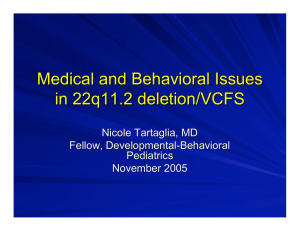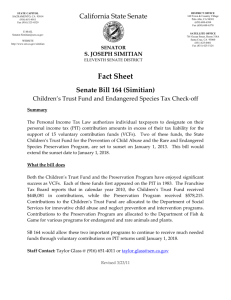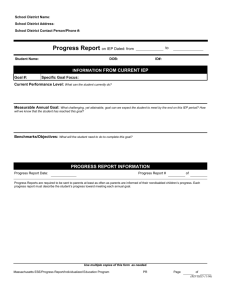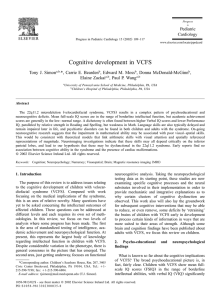Educational Issues for children with Chromosome
advertisement
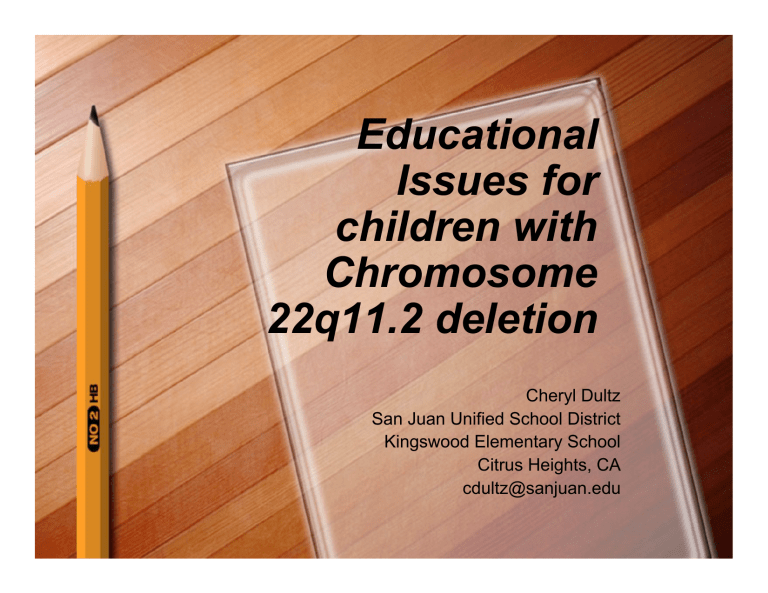
Educational Issues for children with Chromosome 22q11.2 deletion Cheryl Dultz San Juan Unified School District Kingswood Elementary School Citrus Heights, CA cdultz@sanjuan.edu What are some questions concerning VCFS and education? ! What is the research on VCFS and learning? ! What does VCFS look like in a classroom? ! What are some instructional strategies and accommodations that can help my child succeed? ! What are some specific strategies for mathematics instruction? ! How can I get the most effective IEP for my child? ! How can I help my child at home? Every brain is uniquely organized " " Just as every individual has a unique thumbprint, every individual’s brain is unique. Students will learn in various ways because they have different prior experiences, different dominant learning styles, and different levels of motivation. (Caine) What is the current research concerning VCFS and learning? " " Parietal lobe - The top of the upper brain, it’s one of the four major areas of the cerebrum. This area deals with reception of sensory information from the opposite side of the body. It plays a role in reading, writing, language and calculation. Corpus Callosum - A white matter bundle of millions of nerve fibers that connect the left and right hemispheres. Located in the middle of the brain area VCFS Research and Learning " " Gray and white matter reductions in the parietal lobe suggest that VCFS children have difficulty in both the processing and transmitting of mathematical information. Parietal lobe is also linked to working memory. Working memory is the ability to hold information “on-line” while performing a task. Many children with VCFS face challenges in this area. This is most likely related to subtle alterations in the parietal lobe. (Kates) VCFS Research and Learning " " There is a wide range of abilities within the VCFS population, but virtually all children will need support services in school (Landsman) VCFS children are highly vulnerable to social deficits and psychiatric difficulties that impact learning and functioning (Landsman) Research and Learning " " " There appears to be a neurological basis for the difficulties in attention and spatial issues (Simon) Wiring diagrams of the corpus callosum indicate changes that may affect connectivity (Simon) There are definite neurological differences between VCFS children and normal controls as evidenced by MRI studies (Eliez) What does VCFS look like in a classroom setting ? Areas Of Strength # # # # # # # # # Math calculations Rote Memory Long term memory Spelling and creative writing Decoding words - reading for basic information Computer skills and word processing Rhythm/musical skills Willingness to learn and wanting to please Learning skills in a experiential environment (hands on ) Donna Cutler Landsman - dcutlerl@wisc.edu Learning Challenges # # # # # # Poor working and short term memory Difficulties with math reasoning Difficulties with reading comprehension Abstract concept formation Fine motor/perception challenges Health concerns that may affect alertness Donna Cutler Landsman - dcutlerl@wisc.edu Learning Challenges # # # # # # IQ tests tend to fall around 90 Hearing issues Vision issues Deficits in visual perceptual functioning (ie form constancy ability to recognize an object in different spatial positions) Speech and language delays Anxiety and behavior issues (Landsman) What are some instructional strategies and accommodations that can help my child succeed? What factors lead to learning? " " " " " Motivation and Attention - This is what keeps student interested in learning Frequency - Neural pathways need repeated exposures to learning. Intensity - Learning requires vigorous practice Cross training - Teaching for memory requires strong networks that can connect to other networks. Adaptivity - Instruction must be monitored and adjusted How to Teach so Students Remember- Marilee Sprenger Rules for Strengthening Learner Memory • • • • • • • • Foster Attention Ask Questions Use novelty Personalize the learning Use movement Use rhyme and song Use repetition Create associations (Eric Jensen) Applying Brain Research To Teaching Attention: Getting It • Novel • Intensity • Movement …and Keeping It • Emotional • Relevant • Meaningful " Applying Brain Research To Teaching " Hands On/Minds On Activity Meaningful & Relevant • Associations • Activate Prior Knowledge • Repetition • Sheltered Instruction • Multiple Intelligences • Concrete Experiences • Make “pictures” in their minds ~ vocabulary ~ note-taking (de la Maza) Applying Brain Research To Teaching " " Emotional • Simulations & role plays • Solving real life problems • Cooperative & Individual Work • Hands on • Music Checking for Understanding • How do you know that they know (informal assessment) (de la Maza) Memory Strategies " " " " " Mnemonic devices (i.e..My Very Eager Mother Just Served Us Nine Pizzas -Mercury, Venus, Earth,Mars, Jupiter, Saturn, Uranus, Neptune, Pluto) Peer Teaching - Talking out loud releases acetylcholine which is one of the key neurotransmitters that aids in long term memory Review games Music/Rhymes Take notes in color Helen de la Maza Educational Accommodations and Strategies P -12 Preschool • Speech and language acquisition and development • Occupational Therapy Assessment (fine motor skills such as cutting, coloring, printing, using tools, sensory integration) • Physical Therapy (gross motor skills such as balance, walking, running, stamina A.P.E.) • Social Skills development (separation from parents, ability to listen in a group, etc) • Basic cognitive skill development (Landsman) Primary Elementary Ages 5 - 10 • There needs to be cooperation between home and school • New state frameworks require “universal access” for extra support students - these materials can be helpful with preteaching/reteaching • Opportunity to take tests with special education teacher with additional time given • • • • Books on tape Reading telephones Direct instruction especially in math Material presented visually, preferential seating, FM system • Give opportunites for creative projects • Teach keyboarding and provide access to computers (Alpha Smart) • Use of memory techniques and cues (Landsman) Ages 5 - 10 years • Use music to learn information • Teach organization • Communicate with all teachers( art, music, PE., etc.) • Direct instruction on social skills and perhaps partial exclusion from school discipline plan • Speech, occupational, physical therapy services (Landsman) Middle School Years (11-13) • Academic demands will increase, VCFS students will need more support to succeed • Memory problems, attention deficits and medical challenges are major obstacles for a young adolescent • Allow multiple attempts to succeed • Teachers must check for understanding Ages 11-13 (cont) • Teach life skills (money management, cooking, organizing/maintaining room, caring for a pet, doing odd jobs to help) • Continue to teach social skills and place children in activities that require interaction with others in a supervised setting • Teach communication/problem solving (Landsman) Secondary/High School (ages 14-18) • Encourage students to take the classes they can realistically handle. Some VCFS children are mainstreamed into regular classes with support and they complete the requirements for a regular diploma. Others complete more of a life skills curriculum with job placement rather than college as a long term goal. • Emphasis should be on maximizing potential Ages 14-18 (cont.) • Continue accommodations from elementary/middle school (books on tape, extended test time, re-teaching 11, notes, simplified instructions, templates for writing, study guides, graphic organizers etc) (Landsman) Classroom Accommodations • • • • • • • • • Computers available to help with fine motor issues (Alpha Smart) “Handwriting without Tears”program helpful with fine motor issues Preferential seating Model rather than just explain-material is visual and auditory Consider an FM system Use graphic organizers (ex. Venn diagram) Provide notes and handouts in upper grades Check for understanding after students are on independent practice and give 1-to-1 help Home/School communication program in place (Landsman) Classroom Accommodations • Identify key concepts and skills • Preteaching of key standards to increase student confidence (California requires that these standards are identified with lessons through “Universal Access”)This can be done at home or done in Special Education setting • Students can be given additional time to complete assignments and tests • Consider alternative assessments Mathematics and VCFS The Mathematics Classroom # The cognitive load required in learning math is extensive (visual,language, number - all require different parts of the brain) # The social-emotional component involved in learning math (Gallaway) How Do We Help Children with Learning Disabilities in Mathematics ? $ Memory • Allow students to use a pocket-size fact chart, blackening over each fact as it is memorized to discourage over reliance on the chart • Teach strategies for facts • Use mnemonics or ‘catchy sayings’ • Help students visualize and verbalize • Include a daily period of review (Gallaway) How Do We Help Children with Learning Disabilities in Mathematics ? $ Attention/Sequencing • Highlight operation sign • Provide opportunities to visualize relationships • Create mnemonics for how to check over work (ie. estimate,multiply, subtract, bring down) ? X ! • Have students write down the process for solving the problem and refer to it as they work through the problem (Gallaway) How Do We Help Children with Learning Disabilities in Mathematics ? $ Language of math/auditory processing • Slow down pace of delivery • Provide information in small chunks • Ask students to verbalize what they’re doing • Have students read problems aloud before and and after computing them • Preview any vocabulary • Provide students with key words that will point to appropriate operation • Encourage students to draw pictures (Gallaway) How Do We Help Children with Learning Disabilities in Mathematics ? $ Social and Emotional • Understand that students want to learn and retain information. They are frustrated because they have difficulty with memory and they do not know how to correct it • Provide students with opportunities for success • Preteach lessons to reduce anxiety • Recognize that one method for teaching math will not work with every student (Gallaway) How Do We Help Children with Learning Disabilities in Mathematics ? RESOURCES Great Source Education Group: Math on Call (www.greatsource.com) Larry Bradsby, Algebra I Rescue ! (www.sopriswest.com) www.mathstories.com www.factmonster.com www.criticalthinking.com www.activityresources.com How can I design an effective IEP for my child? What aspects of the current California frameworks are intended to make curriculum accessible to special needs students? California Curriculum " " " " State Frameworks (determine what is taught in the public schools - new component is Universal Access) Publishers submit materials to state committee for review State “adopts” published material that the committee determines meets the framework requirements District can only purchase adopted materials with textbook money Classroom Requirements " " " Core Instruction - Standards based instruction using adopted materials Strategic Intervention - Students within one year of core who need extra support Intensive Intervention - Students who are 2 or more years below grade level instruction Access to Core " " " " " Published materials that preteach and reteach key standards from core Preteaching is an effective way to improve access to core instruction ALL current adopted materials must provide support for strategic intervention (intensive intervention is a separate adoption) Extra Support Handbooks provide opportunities for both preteaching and reteaching of key standards Consider looking at the English Language Support materials for remediation. These handbooks tend to be hands on or experiential and focus on visual presentation. This is in contrast to just being more practice of the concept or skill. Preparing for an IEP 1. Learn special ed lingo 2. Do your homework. Find out what programs are available. Where are they located? 3. Research programs that are available in the district, county, and maybe private 4. Visit programs and collect information 5. Parents have the right to bring in other evaluations. You also have the right to give a report. Share information regarding VCFS and accommodations Individuals with Disabilities Act - IDEA Law " " " " " New features - Parents are now an integral part of the process Parents can refer for special education qualification testing at the local school district Parents can also initiate a 504 referral if their child does not qualify under IDEA Parents can submit their own documentation for consideration (neurological test results) Qualification Categories: Speech and Language, Learning Disabilities, Other Health Impairment, and Behavioral Disabilities Acronyms in Education • IEP - Individual Education Plan • SST- Student Study Team • RSP - Resource Program (supplements the regular classroom) • SDC - Special Day Class • CH - Communicative Handicapped (varies GREATLY by district) • PCC- Preschool Communication Class Standardized Testing " " " " Most children with VCFS will require special education services 90-100% Each child is unique and has specialized needs Standardized tests are required for special education placement Medical test results should be considered when meeting with the IEP team Nonverbal Learning Disorders (NLD)-General Characteristics " " " " " Verbal IQ scores are significantly higher than mean performance Reading for comprehension is more difficult than single word reading. Reading deficits tend to increase with age Math skills are poor Difficulty in subjects that involve complex problem solving and concept formation Richard Matte - Nonverbal Learning Disabilities: An Overview Identification of NLD NLD identified from a pattern of neuropsychological strengths and weaknesses & developmental history – No one specific test reveals NLD – Classification rules are emerging but not yet agreed on " Strengths: – Auditory Perception/Attention, Phonological Processing, Rote Verbal Learning " Weaknesses: – Visual & tactile perception/attention & memory, complex psychomotor, executive functions, novel material, concept formation, problem solving, semantics/pragmatics PLACER COUNTY OFFICE OF EDUCATION (PCOE) and ROCKLIN UNIFIED SCHOOL DISTRICT (RUSD) Special Education Program Configurations This information is collected during program visitations (arranged after program-availability research is complet e ) PCOE Communication RUSD Special Day Class RUSD Resource Services Delays & Disorders (CDD) (SDC) Program (RSP) COURSE MATH Class Size: <15 # Teachers/Aides: 1/1 Accelerated Math (AM) or grade-level group work or customized work Grade-Level CDD Curriculum SCIENCE Grade-Level CDD Curriculum LANGUAGE ARTS Grade-Level CDD Curriculum SOCIAL STUDIES Class Size: 15-20 (?) # Teachers/Aides: 1 / 1 Below-grade-level SDC curriculum - or supervised AM Below-grade-level SDC curriculum (extremely elementary) Below-grade-level SDC curriculum (extremely elementary) Below-grade-level SDC curriculum (extremely elementary) Grade-Level Class Size: 33-38 RSP Class Size: <10 # Teachers/Aides: 1/1 Grade-level classroom curriculum with modifications - or AM pullout to RSP classroom Grade-level classroom curriculum with modifications (subjective and inconsistent) Grade-level classroom curriculum with modifications (subjective and inconsistent) Grade-level classroom curriculum with modifications (subjective and inconsistent) ELECTIVE Yes: Student selects Yes: Student selects No: RSP Classroom - Study Time P.E. Yes: modify as needed Yes: modify as needed Yes: modify as needed SPECIAL SERVIC E S As Needed: Speech, OT, etc. As Needed: Speech, OT, etc. As Needed: Speech, OT, etc. Name : Date: ____________________________ ____________________________ OPTIMAL LEARNING ENVIRONMENT for the 22q/VCFS Child Original-Placement IEP or Transition IEP Special Education Program Comparisons Worksheet Program REQUIRED PROGRAM FEATURES (sample) ACADEMI C 1) 2) 3) 4) 5) 6) 7) CLASSROOM STRUCTURE 1) 2) 3) 4) SOCIAL 1) 2) 3) 4) 5) OTH E R 1) 2) 3) A (! ) Program B (! ) Program C ( !) Name : Date: ____________________________ ____________________________ OPTIMAL LEARNING ENVIRONMENT for the 22q/VCFS Child Original-Placement IEP or Transition IEP Special Education Program Comparisons Worksheet Program REQUIRED PROGRAM FEATURES (sample) ACADEMI C 1) academic units are enriching and meaningful (at child’s academic level as much as possible (compare Regular, SDC, and RSP progra m s ) 2) lessons are delivered by direct instruction (vs. learning-center style) 3) realia is used to teach lessons (relating classroom teaching to real-life situations ) 4) an established central auditory processing program is offered 5) mathematics units are repetitive 6) development of independent study and organizational skills is emphasized 7) speech services are delivered as require d CLASSROOM STRUCTURE 1) classes are small and highly structured 2) routines and/or schedules are consistent (limited class change s ) 3) type of instruction is balanced (small group vs. whole group ) 4) curriculum is scaffolded SOCIAL 1) child’s emotional age is considered 2) peer-group acceptance is encourage d 3) systematic social-skills instruction is offered 4) transition with established friends is possible 5) an on-site support system (neighbors, relatives) is possible OTH E R 1) listening devices (FM Trainer, etc.) 2) personal computer and/or Alpha Smart (for note taking and assignments) A (! ) Program B (! ) Program C ( !) How can I help at home ? Help your child with organization check backpack, make a calendar etc Break down large assignments into smaller units - use simple language and several concrete examples Ask your child to repeat back to you what they understand Make flashcards Helping at Home • Encourage physical activity • There is a positive correlation between music and math • Consider hiring supplemental programs (Kumon, Sylvan Learning,Fast ForWord) • Seek involvement in outside group activities to encourage friendships and social skills Current Commercial or Published Material • Computer Software (can provide repetitions-some are adaptive) • • • • example Math Blaster, Accelerated Math Flashcard Program Kumon home program (reading and math) Central Auditory Processing Programs (Fast ForWord, Lindamood Bell, Earobics) School core language arts programs with frequent comprehension checks School Mathematics Programs that use a direct instruction approach KNOWLEDGE IS HOPE Neuroplasticity is the lifelong ability of the brain to change as a result of new experiences and new learning. Collaboration between parents and researchers have increased the knowledge base regarding VCFS. This knowledge base will lead to interventions to help our students reach their potential. KNOWLEDGE IS HOPE References Kevin Antshel. “Cognitive and Behavioral Parameters Associated With VCFS”, The 10th Annual Meeting of the Velo-CardioFacial Syndrome Educational Foundation, Inc., and the Fourth International Conference for 22q11.2 Deletions Atlanta,Georgia July 2004 R. Caine and G. Caine. Making Connections: Teaching and the Human Brain. New Jersey: Dale Seymour Publications 1994 Stephan Eliez. “Brain Imaging, Development, Cognition, and Memory in VCFS”,The 10th Annual Meeting of the VeloCardio-Facial Syndrome Educational Foundation, Inc., and the Fourth International Conference for 22q11.2 Deletions Atlanta, Georgia July 2004 References Katie Gallaway. “Math, I Just Don’t Get it !” California Mathematics Council Northern Conference, Asilomar, California December 2004 Helen de la Maza. “Brain Compatible Learning: Understanding and Implementing Effective Instruction” California Science Teachers Association State Conference Palm Springs, California October 2005 Carrie Heran. “IEP Planning Tool” Family Advisory Council Meeting October 2005 References Eric Jensen. Teaching With the Brain in Mind 2nd Edition Alexandria, Virginia: Association for Supervision and Curriculum Development 2005 Donna Landsman. “Issues in Education” The 10th Annual Meeting of the Velo-Cardio-Facial Syndrome Educational Foundation, Inc., and the Fourth International Conference for 22q11.2 Deletions Atlanta, Georgia July 2004 Ingrid Leckliter. “Identification of NLD and Standardized Testing” M.I.N.D. Institute Sacramento California 2005 References Wendy Kates.”How Does Brain Anatomy Affect Learning in Children with VCFS?” VCFS Educational Foundation Newsletter Volume 8, Issue 3 December 2002 Richard Matte.; Jon Bolaski “Nonverbal Learning Disabilities; An Overview” Intervention in School and Clinic, Sep98 p39-46 Tony J. Simon. “Brain Structure, Connectivity, and Cognitive Function” The 10th Annual Meeting of the Velo-Cardio-Facial Syndrome Educational Foundation, Inc., and the Fourth International Conference for 22q11.2 Deletions Atlanta, Georgia July 2004 References Marilee Sprenger. How to Teach So Students Remember Alexandria, Virginia;Association for Supervision and Curriculum Development, 2005 David Sousa. How the Special Needs Brain Learns Thousand Oaks, California; Corwin Press 2001 Northern California VCFS Support Group Carrie and Colin Heran vcfsparent@aol.com Cheryl Dultz cdultz@sanjuan.edu Donna Cutler Landsman dcutlerl@wisc.edu Velo-Cardio-Facial Education Foundation vcfsef.org
